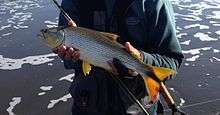Salminus brasiliensis
| Dorado | |
|---|---|
emBonito.jpg) | |
 | |
| Scientific classification | |
| Kingdom: | Animalia |
| Phylum: | Chordata |
| Class: | Actinopterygii |
| Order: | Characiformes |
| Family: | Bryconidae |
| Genus: | Salminus |
| Species: | S. brasiliensis |
| Binomial name | |
| Salminus brasiliensis (G. Cuvier, 1816) | |
| Synonyms | |
|
Salminus cuvieri Valenciennes, 1850 | |
Salminus brasiliensis (dorado, golden dorado or jaw characin) is a large river fish found in central and east-central South America. Despite having Salminus in its name, the dorado is not related to any species of salmon, nor to the saltwater fish also called dorado. It is very popular among recreational anglers and supports large commercial fisheries.
Description
The golden dorado has a large head, with powerful jaws filled with sharp teeth. It reaches maturity around 37 cm (15 in) long, and is golden colored. The average size of the golden dorado is about 3–10 kg (6.6–22.0 lb). The largest recorded size is 100 cm (39 in) length and 31.4 kg (69 lb).[1]
Distribution and habitat
The golden dorado lives in warm freshwater habitats in southern Brazil, Paraguay, Uruguay, Bolivia, and northern Argentina, in the river basins of the Paraguay, Uruguay, Chapare, and Mamoré Rivers, and the drainage of the Lagoa dos Patos.[1] The dorado is considered an endangered species in Paraguay, so a five-year fishing ban was put into effect there.[2] Other South American river basins hold relatives of this species: S. franciscanus in the São Francisco Basin, S. hilarii in the upper Paraná, Amazon and Orinoco basins, and S. affinis in the Santiago and Magdalena basins in Ecuador and Colombia.
"Dorado", both in the name of the fish and other uses such as the El Dorado legend, originates from the Latin word for gold, auratus (later modified into dauratus in Vulgar Latin, and subsequently oro in Spanish and ouro in Portuguese).
Diet
Golden dorados are piscivores, eating a wide variety of prey fish. One of the dorado's favorite prey is the sabalo, a type of schooling fish typically 1–4 kg (2–9 lb) in weight. They also actively prey for several species of Astyanax, also known as lambari, within these especially A. altiparanae, A. bimaculatus, and A. fasciatus, as well as fishes from the Gymnotidae family, genus Gymnotus and known in Brazil as tuvira or sarapó. Its preference for the two mentioned groups dictate generally the shapes and colors of lures and flies made for dorado.
Fishing
The golden dorado is highly sought-after by anglers, both for its meat that is very appreciated and its fighting ability. The aggressive nature of the dorado, its high jumps, fighting strength and stamina have created a competitive market among anglers from all corners of the world, traversing South American waters in hopes of hooking a dorado.

From the 2000s onwards, the dorado has been increasingly recognized as a fly-fishing targeted species. Its aggressive behavior, fast runs, impressive strength, and brave fighting - frequently going airborne in the attempt to loosen itself from the hook, make this species a must-fish for fly fishermen.
Equipments used range from #6 to #10, depending on the size of the average fishstock. This fish usually takes flies both on surface and sub-surface. It is common the use of Intermediate and Sinking-Tip fly lines in places with fast current, preferred by this species. The Dorado though being an avid hunter, also is a lazy chaser. So, if the fly moves too fast or with short, fast movements the Dorado can just skip attacking.
Flies tied for dorado usually contain lots of flash. This fish likes shiny, colorful flies or black ones when the water is muddy or turbid. In the State of São Paulo, Brazil, flies tied in white and blue also deliver good results.

Due to the Dorado's very sharp teeth, anglers use steel wire or fluorocarbon monofilament bite tippets, to avoid the fish cutting the line.
Culinary preparation
Golden Dorados are excellent to eat and are often barbecued with tomatoes and bell peppers. Often utilized in the making of fish soups they are also popularly fried in South America. The Dorado has a white flaky flesh with a notably high fat content.
References
- 1 2 Froese, Rainer and Pauly, Daniel, eds. (2011). "Salminus brasiliensis" in FishBase. October 2011 version.
- ↑ Law Number 3191/07, Which prohibits the fishing, extraction, collecting and stocking for ulterior commercialization of the species Salminus maxillosus, of common name Dorado fish. (MS Word Document) (In Spanish). Retrieved on 20 November 2010.
| Wikispecies has information related to: Salminus brasiliensis |